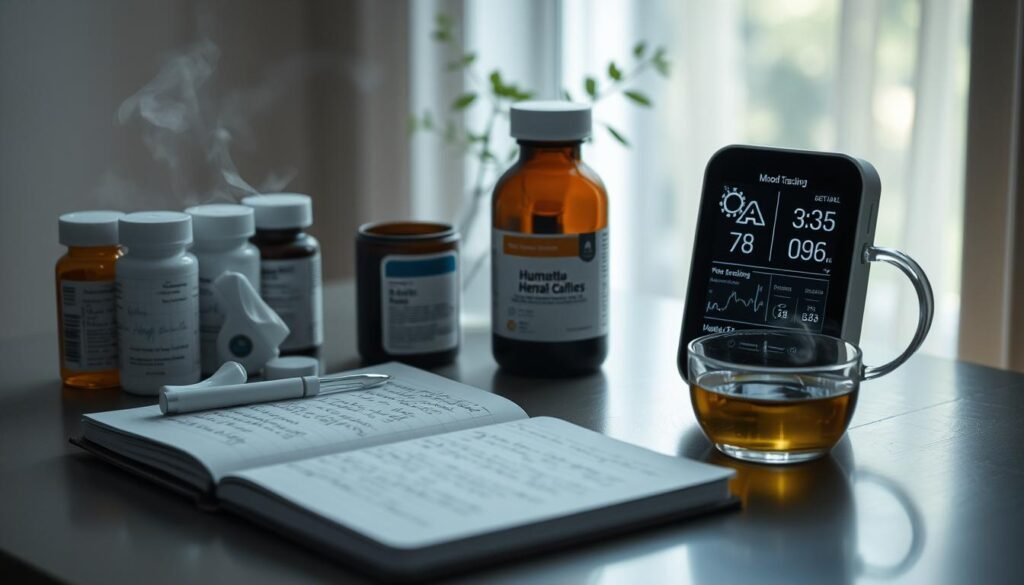Did you know that about 31.1% of U.S. adults face anxiety disorders in their lifetime? This fact shows how crucial effective treatments, like sertraline, are. Sertraline is a selective serotonin reuptake inhibitor (SSRI) often used. Finding the right sertraline dosage for anxiety is key to get the most benefit while keeping side effects low. Factors such as age and individual reaction affect the optimal dosage. In this piece, we will look at sertraline dosage, its role in anxiety management, and guidelines for safe and effective use.
Key Takeaways
- Sertraline is an effective treatment for various anxiety disorders.
- The optimal sertraline dosage varies by age and individual response.
- Understanding dosage recommendations is key to managing potential side effects.
- Dosage guidelines differ for children and adults.
- Gradual dosage adjustments can help mitigate withdrawal symptoms.
Understanding Sertraline and Its Role in Anxiety Treatment
Sertraline is known as a selective serotonin reuptake inhibitor (SSRI). It helps treat anxiety by increasing serotonin levels in the brain. This boost can help reduce anxiety symptoms. Patients often feel better emotionally soon after starting sertraline.
It’s effective in treating several anxiety conditions. These include generalized anxiety disorder, panic disorder, and social anxiety disorder. Studies back its ability in managing these disorders.
The importance of understanding how sertraline works lies in its mood-enhancing ability. A study involved 655 people, equally split between sertraline and a placebo. After six weeks, there wasn’t much change in depressive symptoms between the two groups. Yet, by twelve weeks, there was some sign that sertraline might help reduce these symptoms. This highlights the need for giving it time to work.
Lately, more people are prescribed sertraline, covering mild to moderate symptoms. Antidepressant use has grown in wealthy countries, especially England. As effective treatments like sertraline become more common, they play a crucial part in mental health.
By 2030, depression might lead as the top cause of disability. This fact underlines the importance of drugs like sertraline in managing mental health.
Knowing sertraline’s role in treating anxiety shows we must update psychiatric care. It ensures patients get the right treatment they need for their mental health.
The Importance of Proper Sertraline Dosage
Getting the right sertraline dosage is key for its effectiveness. Taking too much or too little can cause problems. Adults often start with 50mg a day, which may go up to 200mg if needed. Kids between 6 to 12 years start at 25mg daily, with a possible increase to 50mg.
Doctors play a vital role in watching how well sertraline works. They make sure the dose is right, following sertraline dosage guidelines. This is based on how patients respond and what they can tolerate. Teens aged 13 to 17 usually begin with 50mg daily. This dose can also increase to 200mg, depending on the need.
If you take too much sertraline, you might vomit, shake, or have a fast heartbeat. Too much requires immediate medical help. Also, when it’s time to stop taking sertraline, doctors suggest slowly decreasing the dose. This approach helps avoid withdrawal symptoms.
To sum up, the right sertraline dose is crucial for effective treatment and reducing side effect risks. By carefully following dosage guidelines and doctor’s advice, patients have a better shot at managing anxiety well.
Sertraline Dosage Guidelines for Different Age Groups
It’s important to know the right sertraline dosage for managing anxiety in various age groups. Using the correct dose is key for safety and getting the best results. Adults and children need different amounts of sertraline, so dosing must be personalized.
Dosage for Adults
Adults usually start with 50 mg of sertraline a day for anxiety. Depending on how they respond and tolerate it, the dose can change. Some people might go up to 200 mg. Doctors use these guidelines to make sure the dose is just right for each patient.
Dosage for Children and Adolescents
The sertraline dose for young people changes with age and condition. Kids 6 to 12 years old might start at 25 mg a day. Teens 13 to 17 years old could start with 50 mg daily. These starting doses may change to get the best results but won’t go over 200 mg a day for obsessive-compulsive disorder. Following the sertraline dosage guidelines closely, while keeping in mind things like weight and health, helps achieve the best effect.
Sertraline Dosage for Anxiety: Finding the Right Dose
Getting the right sertraline dose for anxiety is very important. It can really change how well the treatment works. Worldwide, about 31% of adults will face anxiety disorders at some point. Doctors often start with a low dose of 25 mg or 50 mg a day. They then adjust the dose depending on how the person responds. This approach helps lower the risk of side effects while easing symptoms.
Research shows that for most, 50 mg of sertraline a day works well. It might take from two to six weeks for the medicine to noticeably lower anxiety. Slowly changing the dose may lead to better management of anxiety with fewer negative effects.
Knowing the possible side effects is important in finding the best dose. Side effects can include reduced sexual desire or sexual issues. There are also more severe risks, like unexpected weight loss, lower sodium in the blood, and a higher possibility of bleeding. Keeping in touch with healthcare providers increases the chance of getting the dosage just right for each person.

Patience and working closely with medical experts are vital to treating anxiety with sertraline effectively. Finding the right medicine and dose can take several months. It depends greatly on each person’s specific situation.
Common Dosage Recommendations for Sertraline
Understanding how much sertraline to take is key for managing anxiety well. The starting dose depends on personal health needs. Most adults begin with 50 mg once a day.
Some people, especially older adults or those with certain health issues, might start with 25 mg. This helps healthcare professionals make safe treatment choices.
Starting Dose Recommendations
The first dose is important to get the treatment right. Adults usually start with 50 mg daily. But, this can change if needed.
The dose can slowly go up, depending on how one reacts to the medicine. Some might need up to 200 mg a day, based on their response.
Adjusting Dosage Over Time
Checking in with a doctor regularly is crucial. They might adjust the dose, up or down, to manage symptoms and side effects well.
An individual plan looks at many things, like other health conditions and medicines. This helps avoid risks, such as serotonin syndrome or bleeding, especially with blood thinners. Patients should always take their medicine regularly and talk about any side effects or concerns to get the best dose.
Optimal Sertraline Dosage for Anxiety: Factors to Consider
Finding the right sertraline dose for anxiety needs a look at several factors. It’s important to understand that the way sertraline works can vary from person to person. This variance depends on each person’s own traits and life situations.
Individual Variation and Response
Things like age, gender, weight, and health status affect how sertraline works for someone. Younger people and those with certain health issues might see different results than older adults. Because of this, doses need to be tailored to the individual. This helps ensure each person gets the best and safest treatment possible. Given that over 40 million U.S. adults deal with anxiety, customizing the sertraline dose is key for good results with few side effects.
Other Medications and Their Impact on Dosage
Using other meds with sertraline can also change how your body deals with it. Some drugs may raise the chance of side effects or reduce how well sertraline works. For example, drugs that up serotonin levels might cause a dangerous condition called serotonin syndrome. Knowing about these drug interactions helps doctors come up with a safe and effective plan. This plan addresses anxiety while also considering other ongoing treatments.
Potential Side Effects of Sertraline
It’s very important to know about sertraline’s side effects if you’re taking it. Knowing both common and severe side effects helps you take care of your health better. If you know what symptoms to look for, you can get help right away.
Common Side Effects
When people start sertraline, they may face some side effects. These usually get better as your body gets used to the medicine. Common side effects include:
- Nausea
- Fatigue
- Headaches
- Drowsiness
- Insomnia
- Dizziness
- Dry mouth
- Loss of appetite
- Diarrhea
Some might feel more anxious or have odd muscle moves, this is more common in kids and teenagers. Issues with sexual function can greatly affect one’s life too.
Severe Side Effects and When to Seek Help
Sertraline can also lead to serious side effects that need quick medical attention. It’s key to know them so you know when to get help. Serious side effects include:
- Serotonin syndrome, with signs like confusion and fast heart rate
- Chest pain or trouble breathing
- Very bad dizziness or passing out
- Reactions like swelling or trouble breathing
- Unexpected stomach bleeding
- Seizures and memory issues
There are long-term risks as well, like changes in blood sugar, which is crucial for diabetics to note. Drinking alcohol can make side effects worse, so it’s best avoided. Watching out for side effects lets you take better care of your health and talk well with your doctor.
| Common Side Effects | Severe Side Effects |
|---|---|
| Nausea | Serotonin syndrome |
| Fatigue | Chest pain |
| Headaches | Seizures |
| Dizziness | Gastrointestinal bleeding |
| Insomnia | Signs of anaphylaxis |
Monitoring Your Response to Sertraline
It’s very important to keep an eye on how well sertraline is working for you. This means checking if the medicine’s dose is right and looking out for side effects. Doctors often ask patients to come back for visits. They do this to see how well the treatment is going and if any changes are needed.
Talking openly with your healthcare team is key. Let them know if you’re feeling different in any way. This helps in keeping track of how the sertraline dose is working. It allows your doctors to fine-tune your treatment. This way, they aim for the best results while keeping risks low. Always take your medicine as your doctor tells you. Skipping doses can mess up your treatment.
Many things can impact how sertraline works for you. These include your age and any other health issues you might have. Things like a past heart attack or heart failure matter too. Being aware of these factors is important. It helps in managing your dosage in a way that’s just right for you. Sometimes, your dose needs to be changed, especially if you’re taking other medicines that could interact with sertraline.

Good monitoring makes sure the treatment stays safe and works well. It supports people dealing with anxiety and depressive disorders. This approach helps patients and doctors work together. They can make a plan that helps improve mental health.
Drug Interactions with Sertraline
Sertraline, also known as Zoloft, is an SSRI for anxiety and mood disorders. Paying attention to drug interactions with sertraline is crucial. Some drugs can cause serious risks when mixed with sertraline. They may make side effects more likely or weaken sertraline’s effect.
When using sertraline, be careful with:
- MAO inhibitors (MAOIs): These can cause dangerous serotonin syndrome.
- Other SSRIs: This might increase side effects.
- Blood thinners: There’s a bigger risk of bleeding.
- Pimozide: This can cause serious heart issues.
- Disulfiram (liquid form): The alcohol in it can increase side effects.
Carefully think about sertraline dosage recommendations. This is important for those with other health issues or on many meds.
Doing detailed checks and watching for changes helps lower risk. Here’s a table of drug interactions:
| Drug Category | Interaction Type | Potential Risk |
|---|---|---|
| MAOIs | Serotonin syndrome | High |
| SSRIs | Increased side effects | Moderate |
| Blood Thinners | Enhanced bleeding | High |
| Pimozide | Heart rhythm disturbances | High |
| Disulfiram (liquid) | Increased nausea/vomiting | Moderate |
Work with your doctor to safely manage meds and get sertraline’s full benefits.
How Sertraline Compares to Other Anxiety Medications
When looking at treatments for anxiety, it’s key to compare sertraline with anxiety medications like Prozac and paroxetine. Sertraline is known for treating anxiety well. It helps with panic attacks and obsessive-compulsive disorder. Studies show it works as well as other meds.
Compared to some other drugs, sertraline is usually easier to handle. It’s less likely to cause dependency, which is a big plus. This feature makes it a good choice for long-term treatment of anxiety. People who want to avoid medication addiction find it suitable.
Sertraline is effective for panic disorder. But, its impact on social phobia and PTSD is less clear. Knowing this helps patients and doctors choose the best treatment.
A detailed study compared different medications. It found sertraline to be a good option because it has fewer side effects. The research shows that it can hold its own against other anxiety treatments. This is mostly because people tolerate it well.
To sum up, sertraline is a strong candidate among anxiety drugs. It’s effective and doesn’t have many negative effects. So, it’s worth considering in treatment plans.

Conclusion
Finding the right sertraline dosage is vital for good anxiety control and minimizing side effects. It’s important for patients to work closely with their doctors. This teamwork lets treatments be fine-tuned to each person’s needs.
In large studies, sertraline helped 62 percent of people stop having panic attacks. Although there were side effects, most felt the benefits were worth it. Only a small group, 9 percent, stopped using it due to these issues.
Success with sertraline depends on personalized care and talking regularly with healthcare teams. With ongoing research, patients can hope for plans that make their lives better.